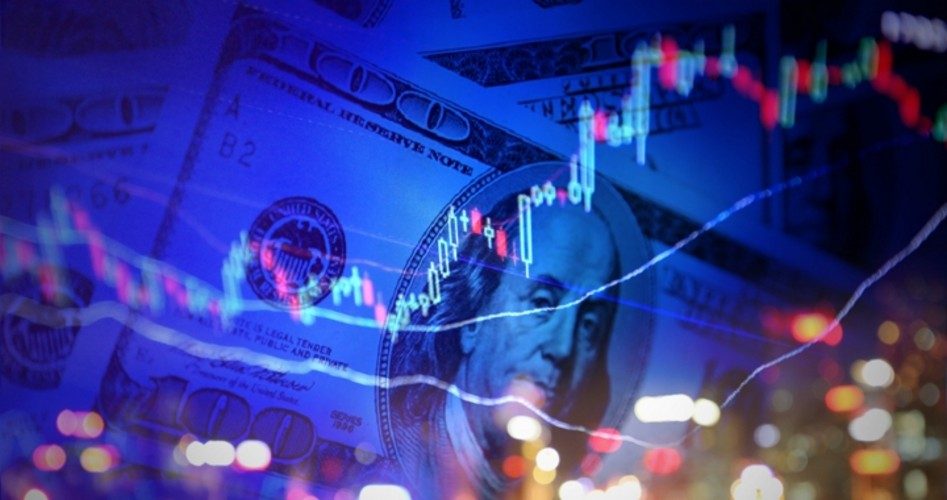
With Wall Street regaining its footing following the decline that started last Thursday, commentators in the mainstream media are still searching for the decline’s cause. Initially they claimed that it was an unexpected surge in inflation evidenced by the rise in the yield of 10-year U.S. Treasury notes approaching three percent (in early September it was closer to two percent). This was followed by the jobs report that announced that wages increased 2.9 percent year-over-year, up from just over two percent previously.
Writers at the Wall Street Journal dug deeper: The selloff was caused by — ready? — “volatility sellers, risk-party funds and algorithmic trading.” They then went into mind-numbing detail about how these strategies work and how the crash cost people using in them in excess of $200 billion.
Peter Schiff, CEO of Euro Pacific Capital, told TheStreet.com that maybe it was the Federal Reserve’s unhappiness with The Donald: “Maybe the Fed would be happy to see a bear market that could be blamed on Trump.” Catherine Rampell, opinion writer for Jeff Bezo’s liberal mouthpiece, the Washington Post, asked rhetorically: “What’s going on? And is Trump to blame?” After all, the crash happened just a few days after Trump’s highly regarded State of the Union message where he went on at some length touting the gains people have made on Wall Street thanks to deregulation and tax reform under his administration.
The answer to these questions is no, no, no, no, and no. The answer remains the obscure announcement made by the U.S. Treasury last Wednesday, the day before stocks began their decline, following advice it was given from an equally obscure advisory committee. That advisory committee, called the Treasury Borrowing Advisory Committee or TBAC, told the U.S. Treasury that it would have to start borrowing trillions of dollars starting immediately because of Trump’s tax reform.
The TBAC “estimated that the Treasury would need to borrow $955 billion in the fiscal year that ends September 30 … [rising] further to $1.083 trillion in fiscal 2019 and $1.128 trillion in fiscal 2020.”
That’s a total of $3.2 trillion that the Treasury would have to raise through the sale of new government notes over the next 32 months. Flooding the market with that amount of new government paper would force interest rates higher in order to accommodate that new supply. Insiders familiar with the inverse relationship of bond prices and their yields could see what was coming and started placing bets that would profit from the coming market selloff.
As The New American noted on Monday, “The only problem with all this is that the TBAC has way overstated the need for the Treasury Department to issue all those new bonds. When tax reform was being considered, the impact on federal revenues was estimated to be approximately $1.5 trillion, and that would be spread over the next 10 years. When economists at the Wharton School at the University of Pennsylvania took a look at tax reform, it estimated that it would add $2 trillion to the national debt, again over 10 years.”
Additional support for the position that the TBAC has deliberately greatly overstated the need for the Treasury Department to raise $3.2 trillion in such a short period of time came from the non-partisan Joint Committee on Taxation, which analyzed Trump’s tax reform law and concluded that it would add only $1 trillion to the national debt by fiscal year 2027, 10 years from now!
The New American then looked into the membership of that obscure committee to see if any of them had a particular ax to grind with the president:
(bit)There are 17 members on the committee, including representatives from JPMorgan Chase; Morgan Stanley; Goldman, Sachs & Company; Citigroup; BNY Mellon; Barclays; and Bank of America. Each of them has a vested interest in advising the U.S. Treasury Department simply because Treasury will look to them to sell those new issues. But those entities also have a political ax to grind as well. In July 2016 the liberal Huffington Post reported that “The party platform approved at the Republican National Convention in Cleveland offers official support for reinstating the Glass-Steagall law, which separates riskier securities trading from traditional commercial banking. The move would require busting up the six largest banks in America.”(eit)
In May 5, 2017, Investors Business Daily reported, “President Trump’s hint this month of a breakup of big Wall Street banks such as JPMorgan Chase (JPM), Bank of America (BAC), Goldman Sachs (GS) and Wells Fargo (WFC) hit their stocks hard.”
The irony, and perhaps the intention, is that under present law those banks advising the U.S. Department of the Treasury can still trade the markets thanks to Glass-Steagall using those various strategies outlined by the Wall Street Journal. Knowing in advance what impact that announcement would have on the markets leads one reasonably to surmise that that $200 billion missing from investors’ accounts now resides comfortably in the trading departments of those banks.
And Goldman Sachs has all but confirmed that intention by now telling investors that the worst is over and that the water is warm and inviting and safe to jump into once again, just in time for the next fleecing: “Following the selloff, we recommend investors focus [any remaining money they might still have] on cyclicals, low labor cost stocks, and strong balance sheet firms.” Goldman also reiterated its year-end target, following the present fleecing, of 2,850 as measured by the S&P 500 Index. After all, said Goldman, the stock-market selloff is technical in nature and not due to any back-room maneuvering by its trading department and those of its friends on the committee.
Image: honglouwawa via Getty Images
An Ivy League graduate and former investment advisor, Bob is a regular contributor to The New American magazine and blogs frequently at LightFromTheRight.com, primarily on economics and politics. He can be reached at [email protected].
Related article:
Treasury Advisory Committee Says U.S. Must Borrow Trillions, Sending Stocks Down



